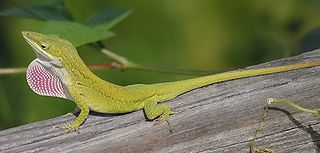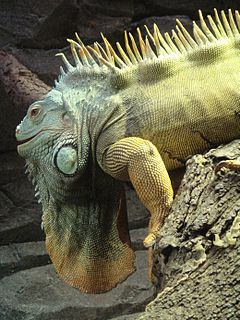
Dactyloidae are a family of lizards commonly known as anoles and native to warmer parts of the Americas, ranging from southeastern United States to Paraguay. Instead of treating it as a family, some authorities prefer to treat it as a subfamily, Dactyloidae, of the family Iguanidae. In the past they were included in the family Polychrotidae together with Polychrus, but the latter genus is not closely related to the true anoles.

The Iguanidae are a family of lizards composed of iguanas and related species which includes species such as the green iguana, the Lesser Antillean iguana and the marine iguana.

Anolis is a genus of anoles, iguanian lizards in the family Dactyloidae, native to the Americas. With more than 425 species, it represents the world's most species-rich amniote tetrapod genus, although many of these have been proposed to be moved to other genera, in which case only about 45 Anolis species remain. Previously, it was classified under the family Polychrotidae that contained all the anoles, as well as Polychrus, but recent studies place it in the Dactyloidae.

Polychrus is the only extant genus of polychrotid lizards in the world. Commonly called bush anoles, they are found in Central and South America, as well as nearby Trinidad and Tobago.

The pygmy beaked whale, also known as the bandolero beaked whale, Peruvian beaked whale and lesser beaked whale, is the smallest of the mesoplodonts and one of the newest discoveries. There were at least two dozen sightings of an unknown beaked whale named Mesoplodon sp. A before the initial classification, and those are now believed to be synonymous with the species. The species was formally described in 1991, based on ten specimens obtained from Peru between 1976 and 1989, including a 3.72 m (12.2 ft) adult male as the type specimen. A specimen that stranded at Paracas, Peru in 1955 has since been identified as a pygmy beaked whale. Since 1987, there have been an additional 40 sightings of the species, for a total of 65.
Pristimantis peruvianus is a species of frog in the family Craugastoridae. It is found in the upper Amazon Basin in western Brazil, southern Ecuador, eastern Peru, and southeast Colombia. Records from Bolivia likely refer to an undescribed species, although it is possible that also the "true" Pristimantis peruvianus is to be found there. Its natural habitats are upland cloud forests, flooded lowland forests, and oxbow palm swamp forests. It is a common species.

Noblella peruviana is a species of frog in the family Craugastoridae. It is endemic to the Andean highlands in Peru.
Telmatobius peruvianus, also known as the Peru water frog, is a species of frog in the family Telmatobiidae. This semiaquatic frog is endemic to Andean highlands in southeastern Peru and far northern Chile where found in streams and small rivers. It is threatened by habitat loss, pollution, collection for human consumption and infection by chytrid fungi, and it has not been seen in Chile since 1986.

Polychrus gutturosus, also known as Berthold's bush anole or monkey tailed anole, is a species of lizard found in tropical Central and South America. It is sometimes referred to as a "forest iguana". It lives in forests and jungles from Honduras to Ecuador. It can reach up to 70 cm (2.3 ft) in total length, including its very long tail, and males are considerably smaller than females. This insectivorous lizard is a climbing species that can often be seen holding onto branches. It can even hold on with its hind legs, though it moves slowly that way.

The Polychrotidae family of iguanian lizards contains the living genus Polychrus and the extinct genus Afairiguana. The family Polychrotidae was once thought to encompass all anoles, including those in the genus Anolis. Studies of the evolutionary relationships of anoles based on molecular information has shown that Polychrus is not closely related to Anolis, but instead closer to Hoplocercidae. It is therefore not part of Dactyloidae and instead is treated as the family, Polychrotidae.

Noblella is a genus of frogs in the family Craugastoridae. They are found on the eastern slopes of the Andes and in the Amazon Basin in Colombia, Ecuador, Peru, Bolivia, and western Brazil. The name refers to Gladwyn K. Noble, who described the first species.
Anolbanolis is an extinct genus of iguanian lizards that lived in the Bighorn Basin of what is now Wyoming during the earliest Eocene. The type species A. banalis was named by paleontologist Krister Smith in 2009 from a collection of isolated skull fragments found in a layer of the Willwood Formation that dates to a brief period of global warming called the Paleocene-Eocene thermal maximum (PETM) about 56 million years ago. The genus name Anolbanolis means "poor anole" from the Greek anolbos and the name Anolis, in reference to the scrappy nature of known fossil material and its close resemblance to lizards in the genus Anolis. Smith suggested that Anolbanolis may be a close relative of Anolis or Polychrus, which are common today in Central and South America but not found as far north as Wyoming, fitting with the idea that the Bighorn Basin was warmer and wetter in the Eocene than it is currently. According to Smith, the species name banalis is a reference to it being a "banal" lizard in the Willwood, being "quite abundant in the type locality," and not unusual because "the discovery of Eocene boreal fossil members of living subtropical and tropical clades is becoming commonplace." In 2011 Smith named a second species of Anolbanolis, A. geminus, which lived in the Bighorn Basin shortly after the PETM and was about 50 percent larger than A. banalis. Smith concluded on the basis of features in A. geminus that Anolbanolis is more closely related to Anolis than it is to Polychrus.

Polychrus acutirostris, the Brazilian bush anole, is a species of lizard native to southern and eastern Brazil, Paraguay, Argentina, and eastern Bolivia. It is diurnal.
Polychrus femoralis, or Werner'sbush anole, is a species of anole native to Ecuador and Peru. It can be found in forests and shrublands.
Polychrus jacquelinae or Jacqueline's bush anole is a species of bush anole. It is endemic to Peru and was dedicated to Jacqueline Maria Charles. It can be found in elevations of 1,460 to 1,570 meters.
Polychrus liogaster or Boulenger's bush anole is a species of bush anole native to Peru, Brazil, Bolivia, and Ecuador. The species is found in elevations of around 750 meters.

Polychrus marmoratus or many-colored bush anole is a species of bush anole. It is also commonly referred to as the monkey lizard due to its slow movement. The lizard has many predators, including spiders and primates.
Polychrus auduboni, or smooth-backed bush anole, common monkey lizard, or many-colored bush anole, is a species of anole native to Venezuela and Trinidad and Tobago. It can be found in forests and shrublands.









